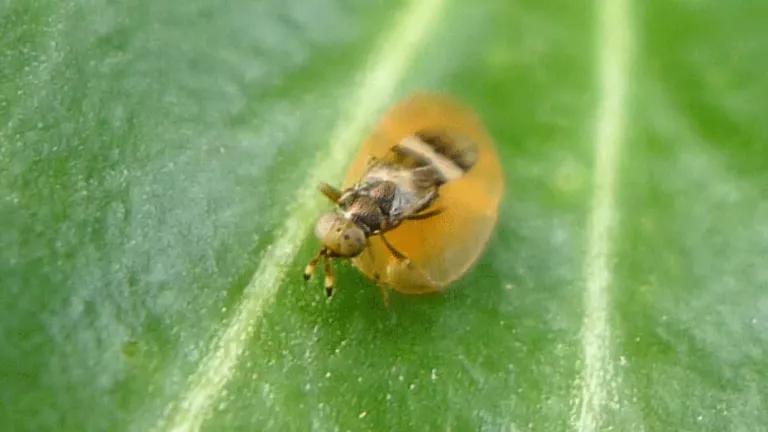Missed Connections
Climate change could affect the way all kinds of creatures interact with each other.

The relationship between this tiny parasitic wasp and its scale insect host could change because of global warming.
Photo: gailhampshire
In nature, timing is everything.
From the mass migration of monarch butterflies to the simultaneous seminal release of corals to the collective deaths of salmon and cicadas, many species stick to schedules so strict, their habits could be used to mark the seasons.
Unfortunately, more and more evidence suggests that climate change has already begun to cuss up these timetables.
Some flowers, for example, seem to be adapting more quickly to global warming than the wild bumblebees they rely on for reproduction. The flowers bloom earlier, often before the bees have emerged to transport pollen between them. As a result, the plants produce fewer seeds. If the two can’t sync up, the lockstep dance of pollination that has developed over millennia may unravel over the relatively short course of centuries—or even decades.
Scientists call this occurrence a “phenological mismatch,” but you could simply think of it as bad timing.
“One thing that happens [with global warming] is that partnerships between all kinds of organisms break down because one partner changes more than another,” says Emily Meineke, a North Carolina State University graduate student and U.S. Environmental Protection Agency STAR fellow. Meineke is currently researching whether one of these mismatches is happening between scale insects and their arch nemeses, parasitic wasps, thanks to urban warming in Raleigh, North Carolina.
Scale insects are small, mostly stationary bugs that suck the life out of trees. But these parasites have parasites of their own. Several species of wasp prey upon scales by drilling into their shells and depositing tiny monster eggs. Once the larva hatches, it lives inside the body of the scale insect, sucking its blood like Voldemort noshing on a unicorn.
But here’s the thing: Scale insects seem to thrive under slightly warmer conditions, while wasps fare no better or worse. Using a thermal map obtained from a Landsat satellite, Meineke collected wasp-infected scale insects from “hot” and “cold” areas across Raleigh. The difference in average temperatures at the sites varied by just a half-degree Celsius, but it’s a case of a little warmth going a long way. In the “hot” areas, scale insects were able to produce twice as many eggs as their counterparts in the “cold” areas.
To be clear, the wasps were still infecting the scales at both places. In the cooler sites, the parasites’ eggs affected the scales’ ability to produce its own eggs. Call it nature’s way of keeping scale insects from taking over the world. But Meineke’s evidence suggests that higher temps allow scale insects to somehow overcome the wasp’s influence.
This may be due to the fact that the scales hatch earlier in warm conditions. And when that occurs, their other life events move up on the calendar, too: earlier molting, breeding, egg-laying.
As for the wasps, their life cycle appears to remain the same in the heat. They still drill into scale insects (which are now a few days or weeks older than normal), lay their eggs, and leave their young to leech off their host. Everything is as it was before, except for the fact that the wasp larvae no longer seem to compromise the egg production of their hosts.
Meineke says this could mean the whole dynamic of their relationship has changed from parasitism (where one species succeeds at a detriment to the other) to something more akin to commensalism (where one species benefits at no cost to the other).
Biologist and study coauthor Rob Dunn admits that such a small shift in the relationship of two tiny insects may seem insignificant, but the findings could be part of a much bigger pattern.
“Increasingly, the warming that is happening in cities seems to be offering us a lens through which we can understand the effects of future global warming,” he says. “And the future is often dependent on complex interactions among species we know little about.”
Not to mention, the trees might give a damn (if they could). A difference of just half- degree Celsius was enough to tip the balance in favor of the scales. The Intergovernmental Panel on Climate Change projects temperatures to increase four times as much over the next century. That kind of heat could potentially hatch a whole lot more tree-sucking bugs.
And what else it might have in store—for the birds, the bees, the salmon, and the cicadas—we just don’t know yet. We’d be wise to start filling out those calendars in pencil.
This article was originally published on onEarth, which is no longer in publication. onEarth was founded in 1979 as the Amicus Journal, an independent magazine of thought and opinion on the environment. All opinions expressed are those of the authors and do not necessarily reflect the policies or positions of NRDC. This article is available for online republication by news media outlets or nonprofits under these conditions: The writer(s) must be credited with a byline; you must note prominently that the article was originally published by NRDC.org and link to the original; the article cannot be edited (beyond simple things such grammar); you can’t resell the article in any form or grant republishing rights to other outlets; you can’t republish our material wholesale or automatically—you need to select articles individually; you can’t republish the photos or graphics on our site without specific permission; you should drop us a note to let us know when you’ve used one of our articles.
1.5 Degrees of Global Warming—Are We There Yet?
When Customers and Investors Demand Corporate Sustainability
How to Make an Effective Public Comment